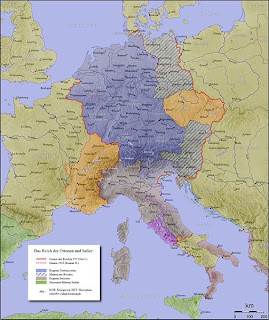This is the second in a series of posts with the intention of outlining the Prussian nobility and of Prussia itself. In my last post, I began to outline the history of Prussia, beginning with a brief history of the Duchy of Prussia, which was later adopted in 1618 by the Margraviate of Brandenburg to form Brandenburg-Prussia.
In this post, I would like to outline a concise history of the Margraviate of Brandenburg, which was one of the major principalities (or princedoms, as in a monarchical feudatory or sovereign state ruled or reigned by a prince or princess) within the Holy Roman Empire beginning in 1157 and ending in 1806. Also known as the March of Brandenburg, it played an extremely important role in the history of Germany as well as in all of Central Europe.
In this post, I would like to outline a concise history of the Margraviate of Brandenburg, which was one of the major principalities (or princedoms, as in a monarchical feudatory or sovereign state ruled or reigned by a prince or princess) within the Holy Roman Empire beginning in 1157 and ending in 1806. Also known as the March of Brandenburg, it played an extremely important role in the history of Germany as well as in all of Central Europe.
Developing out of the so-called Northern March (see dark blue marked area in map below) and founded by a Slavic group, the first margraves were established in accordance with the decrees established during the Golden Bull of 1356 which allowed them to vote in electing the Holy Roman Emperor – the elected monarch to rule over all states contained within the Holy Roman Empire.
The Northern March
Holy Roman Empire 962 – 1806
In 1415, the Hohenzollern family rose to power, under which Brandenburg rapidly grew in power and influence into the 17th century and later adopted the Duchy of Prussia, forming the transitional Brandenburg-Prussia, which then later became the Kingdom of Prussia and the foremost leading state of Germany during the 18th century.
In 1806, the Margraviate of Brandenburg dissolved along with the Holy Roman Empire when the last Holy Roman Emperor, Francis II (from 1804, Emperor Francis I of Austria) resigned after being defeated by Napoleon Bonaparte. In 1815, it became the Prussian Province of Brandenburg and was instrumental in the unification of Germany and the creation of the German Empire in 1871. The title “Mark Brandenburg” is still used today as an unofficial description for the present day state of Brandenburg in the Federal Republic of Germany.
In 1806, the Margraviate of Brandenburg dissolved along with the Holy Roman Empire when the last Holy Roman Emperor, Francis II (from 1804, Emperor Francis I of Austria) resigned after being defeated by Napoleon Bonaparte. In 1815, it became the Prussian Province of Brandenburg and was instrumental in the unification of Germany and the creation of the German Empire in 1871. The title “Mark Brandenburg” is still used today as an unofficial description for the present day state of Brandenburg in the Federal Republic of Germany.
Margraviate of Brandenburg Coat of Arms
Present Brandenburg Coat of Arms adopted in 1990







 Buying Nobility - Noble Titles for Sale (GALLERY)
Buying Nobility - Noble Titles for Sale (GALLERY)








No comments:
Post a Comment